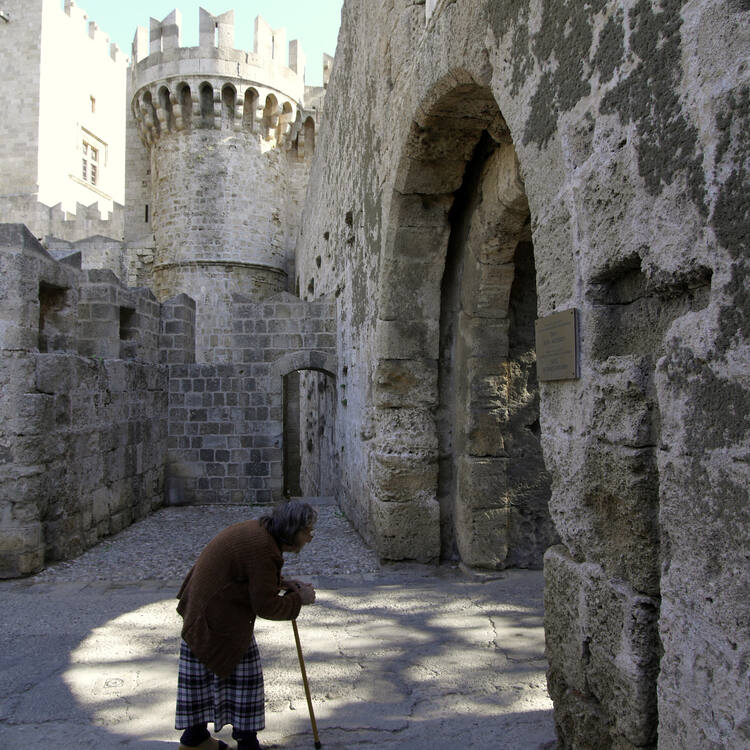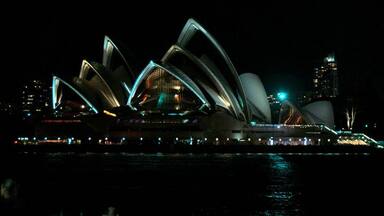Medieval City of Rhodes
Medieval City of Rhodes
The Order of St John of Jerusalem occupied Rhodes from 1309 to 1523 and set about transforming the city into a stronghold. It subsequently came under Turkish and Italian rule. With the Palace of the Grand Masters, the Great Hospital and the Street of the Knights, the Upper Town is one of the most beautiful urban ensembles of the Gothic period. In the Lower Town, Gothic architecture coexists with mosques, public baths and other buildings dating from the Ottoman period.
Description is available under license CC-BY-SA IGO 3.0
Ville médiévale de Rhodes
L'ordre des Hospitaliers de Saint-Jean-de-Jérusalem a occupé la ville de 1309 à 1523 et a entrepris de la transformer en place forte avant qu'elle ne passe successivement sous domination turque et italienne. La haute-ville est l'un des plus beaux ensembles urbains de la période gothique, avec le palais des Grands Maîtres, l'Hôpital et la rue des Chevaliers. Dans la basse-ville, l'architecture gothique coexiste avec des mosquées, des bains publics et d'autres édifices construits durant la période ottomane.
Description is available under license CC-BY-SA IGO 3.0
مدينة رودوس العائدة للقرون الوسطى
احتلّ الفرسان الصليبيون المدينة منذ عام 1309 حتى عام 1523، وأخذوا على عاتقهم مهمة تحويلها إلى مكان حصين قبل أن تخضع تدريجياً للسيطرة التركية والإيطالية. وتشكّل المدينة العليا أجمل المجموعات الريفية العائدة للفترة القوطية بفضل قصر كبار الأسياد والمستشفى وطريق الفرسان. أما في المدينة السُفلى، فتتعايش الهندسة القوطية مع المساجد والحمامات العامة ومباني أخرى شُيّدت في العهد العثماني.
source: UNESCO/CPE
Description is available under license CC-BY-SA IGO 3.0
罗得中世纪古城
1309至1523年,耶路撒冷的圣约翰骑士团占领了罗得城,并开始将其建成要塞。这里随后又相继受到土耳其人和意大利人的统治。上城是最美丽的哥特式城市建筑群之一,有大长老宫殿、大医院和骑士街。下城不但有哥特式建筑,也有清真寺、公共浴池及其他土耳其帝国时期的建筑。
source: UNESCO/CPE
Description is available under license CC-BY-SA IGO 3.0
Средневековый город в Родосе
Орден Св. Иоанна Иерусалимского владел Родосом с 1309 по 1523 гг. и преобразовал город в мощную крепость. Впоследствии город переходил и под власть турок, и под власть итальянцев. Верхний город, с Дворцом Великого Магистра, Большим Госпиталем и Улицей Рыцарей, является одним из наиболее красивых городских ансамблей готического периода. В Нижнем городе готическая архитектура соседствует с мечетями, общественными банями, и другими зданиями, построенными в период власти Оттоманской империи.
source: UNESCO/CPE
Description is available under license CC-BY-SA IGO 3.0
Ciudad medieval de Rodas
La Orden Militar y Hospitalaria de San Juan de Jerusalén ocupó esta ciudad desde 1309 hasta 1523, dedicándose a convertirla en una plaza fuerte. Posteriormente, la ciudad pasó a manos de los turcos y los italianos sucesivamente. El Palacio de los Grandes Maestres, el Gran Hospital y la calle de los Caballeros hacen de la ciudad alta uno de los más hermosos conjuntos urbanos la arquitectura gótica. En la ciudad baja este estilo arquitectónico coexiste el de las mezquitas, baños de vapor públicos y otros edificios que datan del periodo de la dominación otomana.
source: UNESCO/CPE
Description is available under license CC-BY-SA IGO 3.0
ロードス島の中世都市
source: NFUAJ
Middeleeuwse stad Rhodos
Source: unesco.nl
Outstanding Universal Value
Brief synthesis
From 1309 to 1523 Rhodes, the largest island of the Dodecanese, was occupied by the Knights of St John of Jerusalem who had lost their last stronghold in Palestine, in Acre, in 1291. They transformed the island capital into a fortified city able to withstand sieges as terrible as those led by the Sultan of Egypt in 1444 and Mehmet II in 1480. Rhodes finally fell in 1522 after a six-month siege carried out by Suleyman II.
The medieval city is located within a 4 km-long wall. It is divided with the high town to the north and the lower town south-southwest. Originally separated from the lower town by a fortified wall, the high town was entirely built by the Knights. The Order was organized into seven “tongues”, each having its own seat, or “inn”. The inns of the tongues of Italy, France, Spain and Provence lined the principal east-west axis, the famous Street of the Knights, on both sides, one of the finest testimonies to Gothic urbanism. To the north, close to the site of the Knights’ first hospice, stands the Inn of Auvergne, whose facade bears the arms of Guy de Blanchefort, Grand Master from 1512 to 1513. The original hospice was replaced in the 15th century by the Great Hospital, built between 1440 and 1489, on the south side of the Street of the Knights.
The lower town is almost as dense with monuments as the high town. In 1522, with a population of 5000, it had many churches, some of Byzantine construction. Throughout the years, the number of palaces and charitable foundations multiplied in the south-southeast area: the Court of Commerce, the Archbishop’s Palace, the Hospice of St. Catherine, and others.
Its history and development up to 1912 has resulted in the addition of valuable Islamic monuments, such as mosques, baths and houses. After 1523, most churches were converted into Islamic mosques, like the Mosque of Soliman, Kavakli Mestchiti, Demirli Djami, Peial ed Din Djami, Abdul Djelil Djami, Dolapli Mestchiti.
The ramparts of the medieval city, partially erected on the foundations of the Byzantine enclosure, were constantly maintained and remodelled between the 14th and 16th centuries under the Grand Masters. Artillery firing posts were the final features to be added. At the beginning of the 16th century, in the section of the Amboise Gate, which was built on the northwest angle in 1512, the curtain wall was 12 m thick with a 4 m-high parapet pierced with gun holes. The fortifications of Rhodes exerted an influence throughout the eastern Mediterranean at the end of the Middle Ages.
Criterion (ii): The fortifications of Rhodes, a “Frankish” town long considered to be impregnable, exerted an influence throughout the eastern Mediterranean basin at the end of the Middle Ages.
Criterion (iv): This cultural property is an outstanding example of an architectural ensemble which illustrates the significant period of history in which a military/hospital order founded during the Crusades survived in the eastern Mediterranean area in a context characterised by an obsessive fear of siege. Rhodes is one of the most beautiful urban ensembles of the Gothic period. The fact that this medieval city is located on an island in the Aegean Sea, that it was on the site of an ancient Greek city, and that it commands a port formerly embellished by the Colossus erected by Chares of Lindos, one of the Seven Wonders of the ancient world, only adds to its interest. Finally, it must be noted that the chain of history was not broken in 1523 but rather continued up to 1912 with the additions of valuable Islamic monuments, such as mosques, baths and houses.
Criterion (v): With its Frankish and Ottoman buildings the old town of Rhodes is an important ensemble of traditional human settlement, characterized by successive and complex phenomena of acculturation. Contact with the traditions of the Dodecanese changed the forms of Gothic architecture and building after 1523 combined vernacular forms resulting from the meeting of two worlds with decorative elements of Ottoman origin. All the built-up elements dating before 1912 have become vulnerable because of the evolution in living conditions and they must be protected as much as the great religious, civil and military monuments, the churches, monasteries, mosques, baths, palaces, forts, gates and ramparts.
Integrity
The increasing dangers due to the tourist development and the commercial overexploitation of the property, the modification of land use and of building regulations require that the strategic management of the property be continuously strengthened, so that the pressure exerted on the environment and the urban fabric, including all elements from before 1912, will be minimized.
Authenticity
The medieval city of Rhodes maintains the architectural character and the urban organization of a medieval city as well as its primary building materials. The alterations to the fortification walls and the monuments within the city during the Ottoman period did not harm at all the character of the historical settlement, and are unique and integral evidence of the historic layering of the property. The Italian occupation after 1912 left a strong imprint on the urban landscape of Rhodes, with reconstructions of some of the major buildings. They must be considered, nonetheless, as a permanent integral part of the urban history of Rhodes.
Protection and management requirements
The property is protected by the provisions of the Archaeological Law 3028/2002 “On the Protection of Antiquities and Cultural Heritage in general”, and by separate ministerial decrees, published in the Official Government Gazette. Protection and management are carried out by the Ministry of Culture, Education and Religious Affairs through the responsible regional service (Ephorate of Antiquities of the Dodecanese). The Scientific Committee responsible for the execution of restoration projects in the Medieval City of Rhodes is supervised by the Ministry of Culture, Education and Religious Affairs. Since Rhodes is a living city, the Ministry of Culture, Education and Religious Affairs cooperates with the responsible bodies (Public, Regional and Municipal), so that the medieval city of Rhodes can maintain its qualitative features as a perpetually evolving historical settlement.
The protection and management of the medieval city of Rhodes is implemented through continuous and systematic controls of the town-planning framework and of building activity as well as the updating of the institutional and legislative regulations.
Conservation works on the fortifications, monuments, communal spaces and private buildings are still in progress and are funded by the European Union, the state and private resources. Both state and municipal authorities are in charge of issues regarding the day-to-day function of the residential area with the view to preserving more effectively the values of the property.
The Palace of the Grand Masters and the Archaeological Museum of Rhodes have been upgraded in order to promote the property and offer better facilities to visitors (new exhibitions, infrastructures).
The first phase of the urban planning study for the medieval city of Rhodes – which will define specific boundaries for building and use of land within the limits of the property aiming to its preservation and which was elaborated by the Municipality of Rhodes in cooperation with the Ephorate of Antiquities of the Dodecanese – has been approved under conditions which will be incorporated in the second phase. The final study – a Presidential Decree – will become the basis of the management plan.
 View photos from OUR PLACE the World Heritage collection
View photos from OUR PLACE the World Heritage collection

